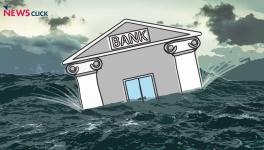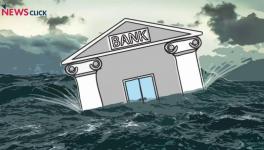Covid-19 and the Education Debt Crisis that the Government is Ignoring

Unemployment is the biggest problem caused by the free-fall of the world economy during the ongoing pandemic, but India’s economy was in crisis even before this catastrophe. The unemployment rate was 6.1% in 2019 and it has only grown worse. A Centre for Monitoring Indian Economy study found in May that the unemployment rate had risen to 27.11%, up from 8.74% in March.
This brings us to students who have taken education loans. In the current employment scenario, many among them will not be able to repay loans. In the last five years the government has reportedly waived off Rs 7,77,800 crore owed by industrialists to banks. India’s indebted students and youth need a helping hand too.
The correlation between education and unemployment is not new. What is new is the idea that loans are a way to secure education in a private institution. Few realise the consequences of student indebtedness. Between 2018 and 2019 more unemployed people ended their own lives in India than even farmers. Besides, India’s educational debt paradigm is similar to America’s. The education loan market in that currently stands at US$130 billion—and one out of every 15 student debt holder dies by suicide.
In India, the first National Loan Scholarship Scheme was introduced in 1962, but the first interest-bearing education loan was introduced in 1991. Vidyalakshmi, an online loan service for students, was announced by the government of India in Budget 2015-16, providing potential applicants information on loans, scholarships and applications of all banks and schemes.
What is also not being acknowledged is that students are taking on debts for education because the government is retreating from its responsibilities in the field. In addition the government is not intervening to control the rising costs of education at private institutions. Instead, the youth are being drawn into a cycle of indebtedness by education institutions and the banking system. The consequences of this are serious. First, the promise of an education loans often comes with assurances by institutions of 100% placement. Yet, the promised jobs often do not materialise, or the jobs do not match the training, skills or salary expectations of the education youth. Students find out that they have been cheated too late—many end up selling their family’s properties to repay their debt.
As privatisation of education grows, the tuition fees for a range of courses has increased immensely, and so have the numbers of student borrowers. However, as unemployment rose and the economic capacities of people waned, the number of borrowers for education declined slightly over recent years. On 31 March 2015 loans were given to 3.34 lakh students, which dropped to 2.5 lakh by 31 March 2019.
In the last five years, NPAs in educational loans have doubled, which has lowered interest in this segment of borrowers among banks. Credit for education has declined by 25% but NPAs have kept on growing. An Indian Banks Association survey records the NPA at 7.3% in March 2016, 7.67% a year later and 8.97% in March 2018.
To get an idea of the scale of these loans, in the year 2000, students across the country borrowed Rs 300 crore, but by 2017-18 this climbed to Rs. 71,724 crore. By comparison, in 2018, individual borrowings of up to Rs. 4 lakh made up 85% of the total NPAs. (The average debt disbursed in India is Rs. 9.6 lakh.) The picture is likely quite similar for 2020, except that due to the Covid-19 crisis, some figures for this year are not yet available. The year 2017 saw a decline of 3.3%, 2018 of 4.7% and 2019 of 5.6% in disbursements of student loans. Due to the growing NPAs of banks, education loans in India have surely declined again—but the figure was already quite high in 2018, as noted above.
Rising NPAs have made the education loan scheme unpopular with private banks, which prefer to lend for other more lucrative purposes. The Reserve Bank of India has noted that 91% of students get their loans from government banks. And, NPAs in home loans are 0.5 to 1%, two-wheelers 2 to 3%, commercial vehicles 3 to 4%. This proportion is much higher in educational loans. However, red tape at government banks motivates students into taking loans from private banks at high interest rates.
An unsecured loan of up to Rs. 4 lakh can be obtained more easily, as collateral is required only for loans above Rs. 7.5 lakh. The loan repayment period, which is generally five to seven years, can be extended to up to 15 years. The State Bank of India has a repayment period of one to 12 years for its loans, while interest rates range from 9.33 to 11.50%. Of course, private bank rates are higher, going up to 15%.
Educational loan schemes in other countries have nominal interest rates compared to India or charge negative rates. For example Sweden has a -0% (negative) rate, Switzerland -0.75% (negative), Denmark -0.60% (negative), Japan -0.1% (negative), the United States 2.75% and so on.
The United States has now proposed that the interest rate on loans after July will be at 2.75% and loans of up to US$10,000 will be waived. The country’s Department of Education has asked for education loan repayment instalments to be relaxed by October and for an interest waiver as well. In addition, the government will repay private educational loans. Besides, the unemployed will receive $600 a week until next year. With the United States bound for elections, President Donald Trump’s challenger Joe Biden has even promised to waive student debt in undergraduate public colleges. But the Indian political class has never discussed student debts in any election ever.
The government of India does not seem to have considered the issue of education loans independently in its financial package to tackle the Covid-19 crisis. Therefore, the RBI initially gave a waiver in repaying general loan instalments. But as the interest continues to be charged, the youth who have taken education loans and are unemployed have nowhere to turn.
The Kerala state government has shown some sensitivity by launching an Educational Debt Repayment Assistance Scheme to partially repay the loans of students whose families earn less than Rs. 6 lakh annually. IIT Delhi has asked the Ministry of Human Resource Development to recover the debts of its students on the basis of the Australian model. A scheme called HELP (Higher Education Loan Program) in Australia is designed so that debt recovery starts only when a student starts working.
An entirely unfavourable environment is being created for the common man by introducing schemes like educational loans. The All India Survey of Higher Education (AISHE) shows that in the academic year 2018-19, 26.3% of the youth are pursuing higher education. In terms of numbers, 3.74 crore students are studying. Out of the total 993 universities in the country, 385 are private. Out of the total 39,931 colleges, 77.8% are private colleges. So by largely privatising higher education, 74% of the younger generation have been deprived of a higher education. Educationists recommend spending at least 6% of the annual budget on education but the allocation for education this year is Rs.99,311 crore or 3.1% of GDP. Out of this, Rs.39,466 crore will be spent on higher education, which is not enough to solve the education loan crisis, which it what needs to be done in India right now.
The author is a research scholar and activist. The views are personal.
Get the latest reports & analysis with people's perspective on Protests, movements & deep analytical videos, discussions of the current affairs in your Telegram app. Subscribe to NewsClick's Telegram channel & get Real-Time updates on stories, as they get published on our website.
























